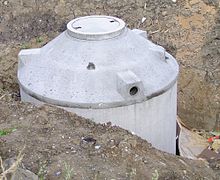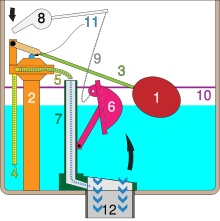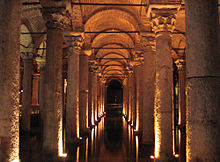Cistern
This article needs additional citations for verification. (April 2023) |

A cistern (from
Cisterns are distinguished from wells by their waterproof linings. Modern cisterns range in capacity from a few litres to thousands of cubic metres, effectively forming covered reservoirs.[citation needed][4]
Origins
Early domestic and agricultural use

Waterproof
Early examples of ancient cisterns, found in Israel, include a significant discovery at Tel Hazor, where a large cistern was carved into bedrock beneath a palace dating to the Late Bronze Age. Similar systems were uncovered at Ta'anakh. In the Iron Age, underground water systems were constructed in royal centers and settlements throughout ancient Israel, marking some of the earliest instances of engineering activity in urban planning.[7]
The Ancient Roman impluvium, a standard feature of the domus house, generally had a cistern underneath. The impluvium and associated structures collected, filtered, cooled, and stored the water, and also cooled and ventilated the house.
Castle cisterns

In the Middle Ages, cisterns were often constructed in
Present-day use

Cisterns are commonly prevalent in areas where water is scarce, either because it is rare or has been depleted due to heavy use. Historically, the water was used for many purposes including cooking,
Some cisterns sit on the top of houses or on the ground higher than the house, and supply the running water needs for the house. They are often supplied by
To keep a clean water supply, the cistern must be kept clean. It is important to inspect them regularly, keep them well enclosed, and to occasionally empty and clean them with a proper dilution of chlorine and to rinse them well. Well water must be inspected for contaminants coming from the ground source. City water has up to 1ppm (parts per million) chlorine added to the water to keep it clean. If there is any question about the water supply at any point (source to tap), then the cistern water should not be used for drinking or cooking. If it is of acceptable quality and consistency, then it can be used for (1) toilets, and housecleaning; (2) showers and handwashing; (3) washing dishes, with proper sanitation methods,[10] and for the highest quality, (4) cooking and drinking. Water of non-acceptable quality for the aforementioned uses may still be used for irrigation. If it is free of particulates but not low enough in bacteria, then boiling may also be an effective method to prepare the water for drinking.[citation needed]

Many greenhouses rely on a cistern to help meet their water needs, particularly in the United States. Some countries or regions, such as Flanders, Bermuda and the U.S. Virgin Islands, have strict laws requiring that rainwater harvesting systems be built alongside any new construction, and cisterns can be used in these cases. In Bermuda, for example, its familiar white-stepped roofs seen on houses are part of the rainwater collection system, where water is channeled by roof gutters to below-ground cisterns.[11] Other countries, such as Japan, Germany, and Spain, also offer financial incentives or tax credit for installing cisterns.[12] Cisterns may also be used to store water for firefighting in areas where there is an inadequate water supply. The city of San Francisco, notably, maintains fire cisterns under its streets in case the primary water supply is disrupted. In many flat areas, the use of cisterns is encouraged to absorb excess rainwater which otherwise can overload sewage or drainage systems by heavy rains (certainly in urban areas where a lot of ground is surfaced and doesn't let the ground absorb water).[citation needed]
Bathing
In some
Toilet cisterns

1. float, 2. fill valve, 3. lift arm, 4. tank fill tube, 5. bowl fill tube, 6. flush valve flapper, 7. overflow tube, 8. flush handle, 9. chain, 10. fill line, 11. fill valve shaft, 12. flush tube

The modern toilet utilises a cistern to reserve and hold the correct amount of water required to flush the toilet bowl. In earlier toilets, the cistern was located high above the toilet bowl and connected to it by a long pipe. It was necessary to pull a hanging chain connected to a release valve located inside the cistern in order to flush the toilet. Modern toilets may be close coupled, with the cistern mounted directly on the toilet bowl and no intermediate pipe. In this arrangement, the flush mechanism (lever or push button) is usually mounted on the cistern. Concealed cistern toilets, where the cistern is built into the wall behind the toilet, are also available. A flushing trough is a type of cistern used to serve more than one WC pan at one time. These cisterns are becoming less common, however. The cistern was the genesis of the modern bidet.[citation needed]
At the beginning of the flush cycle, as the water level in the toilet cistern tank drops, the flush valve flapper falls back to the bottom, stopping the main flow to the flush tube. Because the tank water level has yet to reach the fill line, water continues to flow from the tank and bowl fill tubes. When the water again reaches the fill line, the float will release the fill valve shaft and water flow will stop.
One Million Cisterns Program
In
The rainwater falling on the rooftops is directed through pipelines or gutters and stored in the cistern.[15] The cistern is covered with a lid to avoid evaporation. Each cistern has a capacity of 16,000 liters. Water collected in it during 3–4 months of the rainy season can sustain the requirement for drinking, cooking, and other basic sanitation purposes for rest of the dry periods. By 2016, 1.2 million rainwater harvesting cisterns were implemented for human consumption alone.[16] After positive results of P1MC, the government introduced another program named "One Land, Two Water Program" (Uma Terra, Duas Águas, P1 + 2), which provides a farmer with another slab cistern to support agricultural production.[17]
Notable examples
- Basilica Cistern in Istanbul, Turkey
- Aljibe of the Palacio de las Veletas in Cáceres, Spain
- Cistern in Silves, Portugal
- Matera, southern Italy
- Asa of Judah built a cistern. The prophet Jeremiah was later thrown in it after prophesying the Babylonian invasion
- Cistern in Genesis 37:20, 22
See also
Gallery
-
Staircase leading to the lower levels of the underground cistern of Mycenae, Argolis,
13th cent. B.C. -
Remains of aNabataean cistern north of Makhtesh Ramon, southern Israel
-
Cistern known as
-
Sign indicating a cistern in Japan
-
Plastic cistern
References
- ^ "cistern". Webster's New Collegiate Dictionary (9th ed.). 1990.
- ^ "Cisterns". National Geographic Society.
- ^ ISBN 978-965-221-013-5.
- ^ "Cistern Design" (PDF). North Carolina Department of Agriculture and Consumer Services. Retrieved 2020-04-13.
- JSTOR 124254.
- JSTOR 41223308.
- ISBN 978-965-221-013-5.
- hdl:2286/R.I.43114.
- ^ al-Kibsi, Huda (2007-09-29). "Yemen takes another look at cisterns". Yemen Observer. Archived from the original on 2012-02-08. Retrieved 2020-05-11.
- ^ "Naturnaher Umgang mit Regenwasser" (PDF). Bayerisches Landesamt für Umwelt LfU (in German). Retrieved 2020-04-12.
- ^ Low, Harry (23 December 2016). "Why houses in Bermuda have white stepped roofs". BBC News. Retrieved 30 August 2019.
- ^ Scheidewig. "Geld sparen durch Zisternennutzung". Garten-Zisternen (in German). Retrieved 2020-04-13.
- hdl:2066/183903.
- ^ Pragana, Verônica (2017-12-29). "Acesso à água para produção é ampliado para mais de 6,8 mil famílias do Semiárido". IRPAA - Instituto Regional da Pequena Agropecuária Apropriada.
- hdl:2066/183903.
- ^ "Programa Cisternas democratiza acesso à água no Semiárido". Government of Brazil. 2016.
- hdl:2066/183903.
External links
![]() Media related to Cisterns at Wikimedia Commons
Media related to Cisterns at Wikimedia Commons
- Old House Web - Historic Water Conservation.




![Aljibe of the Palacio de las Veletas [es], Cáceres, Spain](http://upload.wikimedia.org/wikipedia/commons/thumb/5/57/Palacio_de_las_Veletas%2C_aljibe%2C_C%C3%A1ceres.JPG/120px-Palacio_de_las_Veletas%2C_aljibe%2C_C%C3%A1ceres.JPG)


